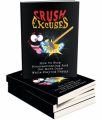Salespage Snapshot:

>>> Click Here To View Full Sales Page…
Table of Contents
Introduction ….. 4
1. Track Visits .. 5
2. Bounce Rate 9
3. Page Views and Average Page Views Per Visit .. 13
4. Track Referrers … 16
5. Track Conversion Rates ……… 18
6. Rate of Return Visitors . 23
7. CLV (Customer Lifetime Value) …….. 26
8. CPA, CPL and ROI …….. 29
Sample Content Preview
2. Bounce Rate
Your bounce rate tells you what proportion of your traffic lands on your site and then immediately leaves. This is a bounce and it basically means that although you have a visit, you aren’t engaging with that visitor and they aren’t stopping to read what you’ve created.
This is a good example of why visits don’t tell the whole story. If you have 1,000 daily visits with a 99% bounce rate, then that means that only 10 people are actually sticking around to read your site!
But bear in mind that a bounce rate still doesn’t tell the whole story. That’s because a bounce rate isn’t based on the amount of time they spend on your site but rather their interaction. So someone might bounce from your site after spending a while there – and this simply means that they didn’t click to read any of your other pages.
So even if you have a bounce rate at about 60%, that doesn’t necessarily mean that visitors aren’t reading your site – they may be reading the page but simply not feeling the need to read further. If your ‘site’ is a one page sales script, then this won’t necessarily be a bad thing!
A good bounce rate is generally thought to be anything from 26%-60% and you can consider anything under 30% to be very much in the ‘outstanding’ category. Being around 40% is very average and shouldn’t be a cause for concern. If you’re about 55%, then you’re getting into the higher portion but again, this is only a cause for concern depending on the type of site that you are
Finally, if you have a bounce rate over 70%, then that is considered poor/disappointing regardless of the nature of your website or blog.
As a general rule, your bounce rate is arguably more important than your visits because it tells you about engagement and what percentage of your traffic is likely to come back, is likely to buy from you and is likely to become a ‘fan’.
A similar metric to this is your ‘average time on site’. This is similar to a bounce rate but can potentially be even more brutal, as it tells you how many of your visitors visited your site, spent a few seconds on your page and then left immediately!
The average time on site metric is a very useful one for illustrating engagement too but as with bounce rates, it’s important not to get too worried if your metric doesn’t look good. The thing to remember is that 55% of visitors will spend fewer than 15 seconds on your website regardless of the content.
You could write an entire article about why this is. Suffice to say that as a species, we humans are becoming more impulsive and more impatient. We always feel busy, we always feel rushed for time and we rarely feel that we have the time to stop and smell the roses – let alone stop and read a website that we find generally interesting!
How to Shrink Your Bounce Rates
The question you really need to be asking yourself, is how you can get your bounce rates lower and your time on site higher.
There are many different factors that play a role here. One such factor is the design of your website and as in real life, first-impressions are incredibly important here! If someone visits your website and they feel that it isn’t particularly attractive or well designed, then this might be enough to cause them to immediately turn and leave!
The colors you use can have a big influence here and it’s worth looking into things like color psychology. For instance, did you know that the color red tends to make people leave faster? Blue and other ‘cool colors’ meanwhile have a calming effect and lead to visitors spending longer on a page as a result.
Another very important thing to look at with regards to your bounce rates is your page load times. Countless studies and reports confirm that this is a huge influencing factor that can be devastating for your site’s performance. If your visitors have to wait even a few seconds for your page to load, they will very often get bored and turn away. Make sure that you use as many speed optimization tricks as you possibly can to help your site appear as soon as the visitor has typed the address into their URL bar and hit ‘enter’. Reduce the number of large images, use AJAX scripts to change the order of loading elements and make sure that you’re on a good hosting package.
Always avoid large blocks of text too. Remember what we just said: people are always in a hurry. They don’t have time to wait for your site to load but they also don’t have time to read through massive swathes of information. You can combat this issue by breaking up your text into smaller, more spread-out paragraphs and by using lots of headings. Ideally, your headings should contain a lot of the information in your site so that someone would be able to skim through your site only reading the headings and still get a complete picture of what it is you want to say.
From there, the key is then to keep checking back to see how your changes are actually affecting your website. This is the entire point of using metrics in the first place – as now by checking back you’ll able to see which of your changes has helped and which has made no difference. Do more of the former and less of the latter!
3. Page Views and Average Page Views Per Visit
Your page views is a metric that sites somewhere snuggly between your views and your hits. This basically tells you how many individual pages have been viewed, regardless of who viewed them or how many times. Thus it might also be referred to as impressions.
Your page views are important in their own way because they tell you how many times the content on your site is being loaded up. And if you have a lot of CPM ads (pay cost per impression), then that tells you how much you’re going to earn from them. It’s also useful to consider aspects like your unique visits vs page views when you look at factors like conversion rates (below). This is useful because each new page view can be considered a new chance for you to impress your visitors.
This metric is closely related to another very useful one: that being the average page views per visit. This is similar to your bounce rate but provides a little more in-depth data that shows you how many different pages your visitor looked around on your site. This is a very useful thing to know because it can tell you whether you are being successful in getting your visitors to not only interact with your site but also to keep reading.
If you think of your visitors in terms of leads, then the visitors who read the most pages on your site are the most engaged with your brand and are thus the ‘warmest leads’. The more page views you get from each visitor, the more likely it is that they will eventually buy when they see your product.
Another related metric/term that you should keep an eye on is your average cost per page view. This tells you how much you are paying to get each hit on your page. If you aren’t doing any paid marketing, then of course this will likely be a very small number (the only cost being your hosting). But if you are spending money on AdWords and other things, then this is a useful way to look at your expenses.
Now this is a metric that won’t be readily available in most dashboards. But the thing to keep in mind is that most of the most valuable metric in internet marketing aren’t; you need to calculate them yourself!
To work this one out, all you need to do is take the average spend on your website and then divide it by the number of page views. Don’t forget to include all your other costs too in order to make this data as accurate as possible.
How to Increase Your Page Views
How do you increase your page views?
Other than by marketing your site to increase visits, the other thing you need to do is to keep your visitors on your page and to keep them reading. Remember how we said that content was the key to SEO and to social media marketing? Well, it’s also the key to engagement. This is why it’s not enough for you to simply create a lot of content – you also need to make sure that your content is top quality and is unique, interesting and generally the sort of thing people actually want to read and stick around for.
You can also use plugins and other techniques to try and encourage people to stick around and go deeper down your rabbit hole. For example, WordPress plugins showing ‘related posts’ can be very helpful in this regard because they suggest similar content based on what the visitor is already enjoying.
Another useful strategy is to make multi-part articles. This is why you will often see posts split into lots of pages: it increases the page views and thereby increases the impressions for adverts that you are earning from!
Note that advertising itself is actually bad for your page views. Why? Because when someone clicks on an advert, they invariably get taken away from your site! Even if the new page opens up in another window or tab, that can still be enough to break the engagement. This is why you shouldn’t put AdSense on a sales page!
Other Details- 10 Articles (TXT)
- 1 Ebook (PDF), 33 Pages
- 1 Salespage (HTML)
- 1 Squeeze Page (HTML)
- Year Released/Circulated: 2017
- File Size: 1,311 KB
License Details:
yes you may giveaway this ebook.
yes you may resell this product. suggested retail price
yes you may resell this product.
yes you may edit the squeeze/salespage.
your customers only get personal use rights only. they may not resell this product.
you may not sell or giveaway private lable rights.
you may not re-title or edit the contents of this product.
you agree to handle any own customer support issues related to this product.













